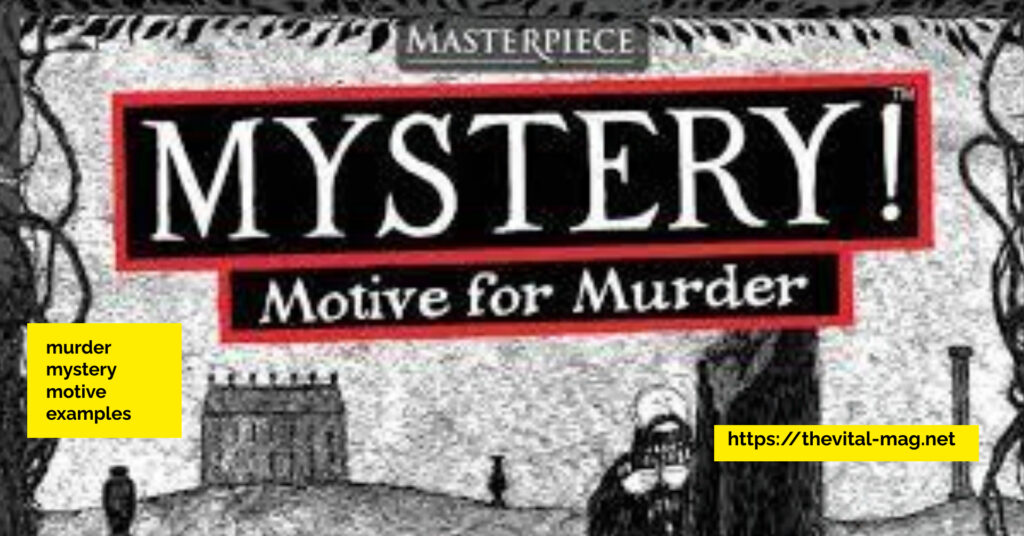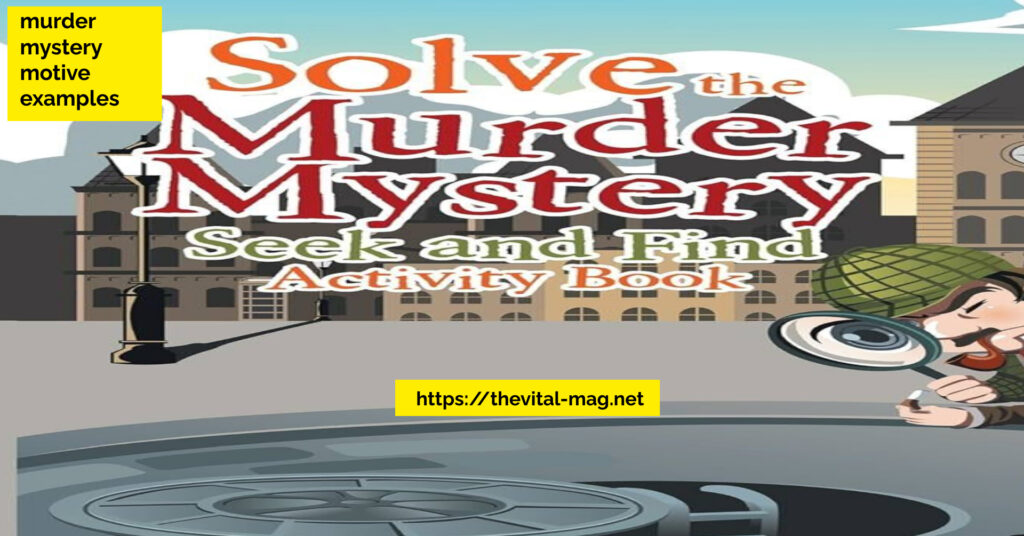Introduction
Murder mysteries often revolve around motives that drive characters to commit the ultimate crime. Common motives include revenge, where a character seeks retribution for a past wrong. For instance, a character might kill to avenge a loved one’s death or to settle a long-standing feud. This type of motive adds depth to the story, as it explores themes of justice and the personal cost of vengeance.
Another prevalent motive is greed, where the desire for wealth or power leads to murder. This can involve inheritance disputes, business rivalries, or a character willing to eliminate anyone standing in the way of their financial gain. Greed-driven motives can make for complex plots, often involving deception, betrayal, and the darker side of human nature.
Jealousy is also a powerful motive in murder mysteries. A character might be driven to kill out of envy, whether it’s for someone’s romantic partner, professional success, or social status. This motive taps into the emotional turmoil that jealousy can cause, making the narrative more relatable and intense.
Hey there! If you’re as hooked on murder mysteries as I am, you know it’s not just about who the killer is but why they did it. Today, we’re diving into what makes a murder mystery truly gripping. We’ll explore the nitty-gritty of crafting these stories, from the motives that drive the killers to how to develop intriguing characters. Let’s get started!
Murder mysteries are all about the excitement of unraveling a crime. Understanding the killer’s motives and the psychological elements involved is crucial for creating a story that keeps readers eagerly turning pages. Let’s break down the core elements that make a murder mystery unforgettable.
Key Points
Understanding Murder Mysteries
Murder mysteries are one of my favorite genres, and they capture a lot of attention for good reason. They involve solving a crime—usually a murder—through a series of clues and investigations.
- Genre Overview: Murder mysteries combine suspense and detective work. The thrill lies in piecing together the clues and discovering who the killer is before the characters do.
- Historical Evolution: From classic whodunits to modern thrillers, this genre has evolved to reflect changes in storytelling and society.
Motives for Murder
So, why do people commit murder in these stories? The motive is a huge part of what makes the plot engaging.
Here’s a quick look at some common motives:
| Motive | Description |
| Greed | Murder driven by the desire for wealth or power. Think inheritance or financial gain. |
| Revenge | Personal vendettas or past wrongs that push someone to kill. |
| Jealousy | Envy over another’s success or relationships, leading to deadly actions. |

Psychological Profiles of Killers
Understanding what makes a killer tick is essential. Here’s a quick rundown:
- Psychopaths: These characters often lack empathy and are manipulative. They can be charming but are dangerous.
- Sociopaths: They might be more prone to emotional outbursts and erratic behavior, driven by personal grievances.
- Trauma: Past experiences and traumas can deeply influence a killer’s motives and actions.
Crafting the Perfect Killer
Creating a killer that stands out is a big part of writing a compelling murder mystery.
- Complexity: A killer should be multifaceted with a backstory that adds depth. The more layered, the better!
- Unpredictability: I love when a story keeps me guessing. Make sure your killer isn’t obvious from the start.
- Relatability: Even if they’re the villain, your killer should have motivations that readers can understand, if not sympathize with.
The Role of Clues in Murder Mysteries
Clues are what keep the mystery alive. Here’s how to use them effectively:
- Subtlety vs. Obviousness: Strike a balance. Too subtle and readers might miss them; too obvious and the mystery fades.
- Foreshadowing: Drop hints about the killer’s identity or actions to keep readers on their toes.
Famous Killers in Literature and Film
Some murderers have become iconic in the world of mysteries. Here are a few:
| Character | Description |
| Professor Moriarty | Sherlock Holmes’ brilliant and sinister rival. |
| Hannibal Lecter | A sophisticated but terrifying character with a complex psychology. |
| Norman Bates | Known for his psychological depth and chilling portrayal. |
The Importance of Setting
The setting can make or break a murder mystery. Here’s why:
- Atmosphere: A well-crafted setting adds tension and mood. It’s not just a backdrop but a key player in the story.
- Cultural Context: The setting can influence the characters’ motives and actions based on societal norms and historical context.
Techniques for Writing Engaging Murder Mysteries
I’ve found that these techniques are crucial for keeping a murder mystery engaging:
- Pacing: Balance suspense with revelation. Don’t rush the plot; build the tension slowly.
- Character Arcs: Develop both your protagonists and antagonists to make their growth and roles in the story meaningful.
Reader Engagement Strategies
Keeping readers hooked is key. Here’s how I approach it:
- Interactive Elements: I love when a story invites me to solve the mystery alongside the characters.
- Cliffhangers: Use these to end chapters or sections, leaving readers eager to find out what happens next.
Common Tropes in Murder Mysteries
Certain tropes pop up often in this genre. Here’s how to use or avoid them:
- The Locked Room Mystery: A classic setup with a seemingly impossible crime scene.
- The Red Herring: Misleading clues or characters that distract from the real killer.
The Role of the Detective
The detective is central to solving the crime. Here’s what makes them interesting:
- Character Traits: A good detective is smart, resourceful, and has a personal stake in solving the case.
- Methods of Investigation: The techniques they use to piece together clues are a big part of the fun.
The Impact of Technology on Murder Mysteries
Technology has changed how murder mysteries are written and solved:
- Forensic Science: Modern techniques play a big role in solving crimes in today’s mysteries.
- Digital Clues: Technology introduces new ways to uncover evidence and solve the crime.
The Influence of Culture on Murder Mysteries
Cultural perspectives can shape how a murder mystery unfolds:
- Regional Differences: Different cultures have unique storytelling styles and motives.
- Historical Context: The historical backdrop can impact the themes and plots of your mystery.
The Art of Misdirection
Misdirection keeps the suspense high. Here’s how to do it:
- Creating Suspense: Use plot twists and unexpected developments to keep readers guessing.
- Layering Clues: Distribute hints throughout the story to maintain intrigue.
The Role of Secondary Characters
Secondary characters can add depth and support the main plot:
- Allies and Antagonists: They enhance the story and add layers to the main narrative.
- Character Development: These characters can provide additional motives or red herrings.

Writing Dialogue in Murder Mysteries
Dialogue is crucial for a believable and engaging story:
- Building Suspense: Use dialogue to reveal or hide important details.
- Character Voice: Ensure each character has a unique way of speaking to make them stand out.
The Importance of Resolution in Murder Mysteries
A good resolution ties up the story neatly:
- Satisfying Endings: Make sure the resolution is logical and resolves the story’s loose ends.
- Character Growth: Reflect on how the events have affected the characters.
The Role of Themes in Murder Mysteries
Exploring deeper themes can enrich the narrative:
- Justice vs. Revenge: Look at the moral implications of the story’s resolution.
- Isolation and Connection: Examine how relationships affect motives and actions.
FAQs
- What are some common motives for murder in fiction? Common motives include greed, revenge, jealousy, and psychological issues. Each adds depth to the killer’s actions.
- How can I create a believable killer in my story? Develop a complex background, relatable motivations, and unpredictable behavior to make your killer resonate with readers.
- What role do clues play in a murder mystery? Clues are key for engaging readers, offering hints about the killer’s identity while maintaining suspense and intrigue.
Conclusion
So there you have it! Crafting a compelling murder mystery involves understanding motives, developing complex characters, and using effective storytelling techniques. Whether you’re a writer or a reader, getting into the nitty-gritty of these elements can make your experience with murder mysteries all the more thrilling. Happy mystery writing!
Top of Form
Bottom of Form






